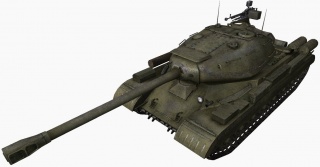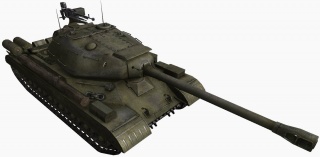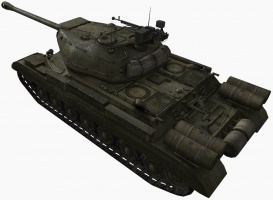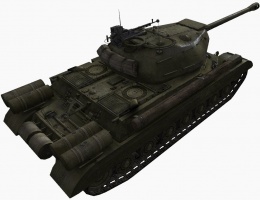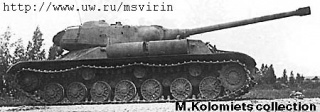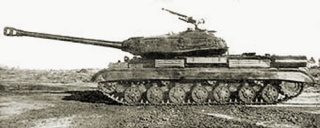IS-4
| Revision as of 14:00, 4 April 2020 Added references, formatted layout of the History | Revision as of 14:01, 4 April 2020 Formatting | |||
| Line 41: | Line 41: | |||
| While the IS-3 programme had been under way in 1944, the design team under engineer L.S. Troyanov began work on a further elaboration of the IS-2 design under the codename Obiekt 701. Several alternatives were proposed on paper, and three designs were presented to the Red Army's tank directorate. These included: | While the IS-3 programme had been under way in 1944, the design team under engineer L.S. Troyanov began work on a further elaboration of the IS-2 design under the codename Obiekt 701. Several alternatives were proposed on paper, and three designs were presented to the Red Army's tank directorate. These included: | |||
| <br><br> | <br><br> | |||
| ? | 1. Obiekt 701-2, armed with the S-34 100mm gun; | + | 1. Obiekt 701-2, armed with the S-34 100mm gun;<br> | |
| ? | 2. Obiekt 701-5, with a different armour configuration; | + | 2. Obiekt 701-5, with a different armour configuration;<br> | |
| ? | 3. Obiekt 701-6, armed with the standard D-25T 122mm gun. | + | 3. Obiekt 701-6, armed with the standard D-25T 122mm gun.<br> | |
| <br><br> | <br><br> | |||
| The latter was accepted for further development. There were three significant changes in the Obiekt 701-6 design: thicker armour, a lengthened hull, and an uprated engine. The basic armour for the hull was increased to 160mm and the turret to 250mm. The 750hp V-12 engine used a revised cooling system influenced by the layout of German Panther tanks, with the radiators under a pair of circular fans. The design was accepted for quantity production as the IS-4 tank in 1947 | The latter was accepted for further development. There were three significant changes in the Obiekt 701-6 design: thicker armour, a lengthened hull, and an uprated engine. The basic armour for the hull was increased to 160mm and the turret to 250mm. The 750hp V-12 engine used a revised cooling system influenced by the layout of German Panther tanks, with the radiators under a pair of circular fans. The design was accepted for quantity production as the IS-4 tank in 1947 | |||
Revision as of 14:01, 4 April 2020
IS-4
Mouse over "
[Client Values; Actual values in
| 6,100,000 |
| 2500500 HP Hit Points |
| 60.02/66.330.08/66.3 t Weight Limit |
- Commander (Radio Operator)
- Gunner
- Driver
- Loader
| 750750 hp Engine Power |
| 43/14 km/h Speed Limit |
| 3030 deg/s Traverse |
| 12.524.93 hp/t Power/Wt Ratio |
| NoNo Pivot |
| // mm Hull Armor |
| 250/200/170250/200/170 mm Turret Armor |
APCR/HEAT/HE
AP/HEAT/HE Shells |
1060/5200/608
1065/5200/630 Shell Cost |
| 390/390/530440/440/530 HP Damage |
| 217/270/61258/340/68 mm Penetration |
|
5.45 r/m ▲
5.22 r/m Standard Gun ▲ Rate of Fire Standard Gun |
|
2125.5 ▲
Standard Gun
▼
Standard Gun
▲
2296.8 Standard Gun ▲
Standard Gun
▼
Standard Gun
▲ Damage Per Minute Standard Gun |
|
0.44 m ▲
0.42 m With 50% Crew: 0.545 m ▲ Accuracy With 50% Crew: 0.52 m |
| 2.9 s 2.5 s Aim time |
| 2525 deg/s Turret Traverse |
| 360° Gun Arc |
| -6°/+16°-6°/+16° Elevation Arc |
| 3030 rounds Ammo Capacity |
| 1515 % Chance of Fire |
| 400 m 400 m View Range |
| 720 m 720 m Signal Range |
Additional Statistics
(Top Configuration)
Camouflage
- Stationary: 6.9%
- When Moving: 3.4%
- When Firing: 1.4%
Terrain Resistance
- On Hard Ground: 1.15
- On Medium Ground: 1.53
- On Soft Ground: 2.59
Dispersion Change Values
- Turret Contribution
- Rotation: 0.08
- Shot Recoil: 3.36
- Suspension Contribution
- Acceleration: 0.24
- Turning: 0.24
With 100% Crew
X
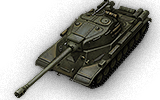
6100000
The IS-4 is a Soviet tier 10 heavy tank.
The project was developed by the Design Bureau of the Chelyabinsk Kirov Plant starting in December 1943. In April 1944 two prototypes of the Object 701 were built. After prototype trials, the design was improved. In late 1944 and early 1945 two more prototypes underwent trials. The Object 701 No. 5 was recommended for adoption into service. However, production was called off in favor of the IS-3 just entering mass-production. After IS-3 production was suspended in 1946, production of the IS-4 began, continuing until 1949. A total of 25 IS-4M tanks were built in 1951. Later all previously produced tanks were modernized to the level of the IS-4M. According to different sources, between 235 and 258 vehicles were built in total; they were stationed in the Far East.
As the final development of its Heavy Tank tech tree, the IS-4 goes for the more versatile "Jack-of-All-Trades/Master-of-None" approach to its in-game performance. Its gun is adequate for its tier, but is quite unimpressive in any single aspect such as accuracy or DPM. Its turret armor is quite strong frontally, but can be easily over-matched when shot through the exposed roof, where it is much weaker. Its hull armor is decent, boasting a tough all-around layout which gives the tank good side-scraping capabilities, but is relatively easy to punch through from the front, even if angled properly. Its mobility is totally different from its quick and nimble brother, the IS-7 with the IS-4 being very sluggish and slow by comparison.
The culmination of these characteristics makes the IS-4 feel like more of a support tank rather than an all out assault leader. While the IS-4 mounts a more accurate 122mm main gun as opposed to the 130mm cannon of the IS-7 and the Object 705A, it still isn't very well suited for long range sniping and if you miss a shot it can be a painful experience. In addition, the tank does not have the speed and maneuverability to get itself into position quickly and relocate if needed. These drawbacks largely restrict the efficiency of the IS-4 to medium and short range brawler-type combat. However, due to the low vertical profile of the tank, it enjoys a somewhat better camouflage rating and can utilize many forms of cover much more effectively - peek out, fire a shot at the enemy, then dive back into safety. But due to its average gun handling, it will require a few seconds to fully aim or risk a hard miss otherwise. All of the above points demonstrate the IS-4 for what it currently is - a Jack-of-All-Trades tank, permitting its driver greater versatility at the expense of any exceptional capabilities.
The IS-4 marks the end of its Soviet heavy line.
Modules / Available Equipment and Consumables
Modules
| Tier | Engine | Engine Power (hp) |
Chance of Fire on Impact (%) |
Weight (kg) |
Price (
| |
|---|---|---|---|---|---|---|
| X | V-12 | 750 | 15 | 1024 | 128000 |
| Tier | Suspension | Load Limit (т) |
Traverse Speed (gr/sec) |
Rmin | Weight (kg) |
Price (
| |
|---|---|---|---|---|---|---|---|
| X | IS-4M | 66.3 | 30 | B/2 | 11000 | 61350 |
Compatible Equipment
Compatible Consumables
Player Opinion
Pros and Cons
Pros:
- Same top gun as the ST-I, with better handling and aim time
- Good armor profile - strong turret armor and thick side hull armor
- Large healthpool, largest among all Soviet heavy tanks
- Low profile compared to preceding tanks in the branch (such as ST-I)
- Good top speed
Cons:
- Sluggish acceleration and average mobility
- Frontal hull armor has several weakspots
- Thin, weak turret roof
- Fairly lacking in DPM, even with all the available boosts
- Below average gun depression
Performance
If played right, the IS-4 can do a decent job. It is best played as a front line support, using its side hull armor to try to negate damage for the team and forcing a breakthrough when the enemy team's defensive efforts falter. The DPM isn't anything to write home about, but it gets the job done.
When angled, the frontal armor can protect from most medium and heavy tank AP shells. With the addition of the HD model, spare track links in the front lower plate provides 20mm more off armor, making it better protected than upper plate above it.
The IS-4 excels in positions on maps where it can reverse angle and is sheltered from artillery. It has 6 degrees of gun depression, which limit its ability to hull down. So the player is advised to seek out even terrain obstacles such as low walls in order for the tank to maximize protection by revealing only it's turret. The excellent turret armor, while not exactly impervious, can still be very difficult to hit and penetrate at a distance.
It is advised to carry the crew from the ST-I over to the IS-4 so that you have a good crew to start with. The first skill all of your crew members should learn is Repair because should your tracks get blown off, you will want to move out of the line of fire as quickly as possible instead of sitting in the open where artillery can shell you. Afterwards, especially in this tier, the Sixth Sense skill is essential for your Commander and should be researched immediately after the Repair skill. You do not want to be left unknowing if your tank is spotted because once artillery zeroes in on your position, the low speed and maneuverability of this tank will ensure that it's already too late to move. In the hands of an experienced player, the IS-4's weaknesses can be negated relatively easily and it's versatility will allow you to adapt to a wide range of situations depending on what is demanded at the moment. Practice angling your armor, finding appropriate cover and sidescrape as much as you can to maximize all the effective points of the tank and win the day for your team.
Early Research
It's impossible to advance from the ST-I without researching the improved gun, so the IS-4 should instantly arrive as an elite tank.
Suggested Equipment
Gallery
Historical Info
1. Obiekt 701-2, armed with the S-34 100mm gun;
2. Obiekt 701-5, with a different armour configuration;
3. Obiekt 701-6, armed with the standard D-25T 122mm gun.
The latter was accepted for further development. There were three significant changes in the Obiekt 701-6 design: thicker armour, a lengthened hull, and an uprated engine. The basic armour for the hull was increased to 160mm and the turret to 250mm. The 750hp V-12 engine used a revised cooling system influenced by the layout of German Panther tanks, with the radiators under a pair of circular fans. The design was accepted for quantity production as the IS-4 tank in 1947
After a short production run of only 200 tanks, IS-4 production was halted. The main criticism was that the speed and the mobility of the vehicle were inadequate. In the summer of 1950 after the outbreak of the Korean War, nearly all of the IS-4 regiments were shipped to the Far East. They were deployed to form the shock force for a tank army that Stalin was organising to intervene in the Korean conflict. In spite of intense pressure from the Chinese, Stalin decided against intervening in Korea for fear it would result in the outbreak of a general war with the nuclear-armed American armed forces. The IS-4s remained in the region and in the late 1950s, they were modernised along the same lines as the IS-3M, remaining in service into the 1960s. Currently preserved at the Kubinka armour museum near Moscow, the IS-4 shows physical similarity to the IS-2 and was the heaviest tank series ever produced in the USSR.
There have been repeated reports that several superheavy tanks were under development in the Soviet Union in 1945, including a 150 ton tank. However none of these designs appear to have progressed beyond paper studies, or they remain so secret that they still are not discussed today. Among these designs were reputed to be the Vladimir Lenin VL-1, fitted with a front mounted engine and rear mounted turret.
Historical Gallery
Historical Accuracy Errata
*Like many soviet tanks in game the IS-4 has increased gun depression. In reality it had -3° instead of -6°
- The IS-4 was never equipped with the M62 122mm cannon although the gun itself was designed to be able to fit all D-25T mounts
















